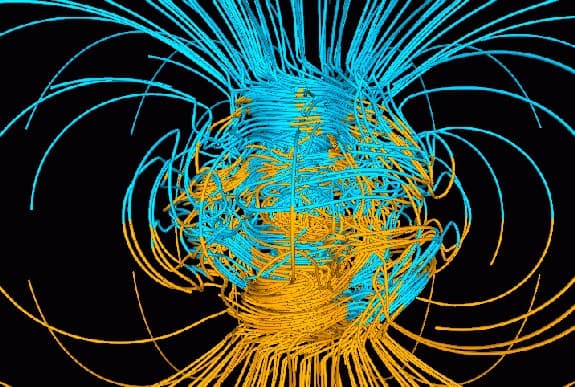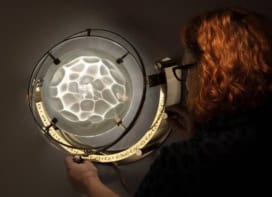
Messy business The Earth’s magnetic field found itself entangled in a controversial article
By James Dacey
Ben Goldacre is probably best known for his razor-sharp column Bad Science, through which he launches weekly attacks on shock reporting, big business, and basically anyone else who is deemed to misrepresent or skew science for their own unsavoury ends.
Now, it seems however that his column has committed one of the same indiscretions it purports to attack – sensationalism. Goldacre’s newspaper, The Guardian, has been forced to publish an apology for an article in which Goldacre drew an “unfair” parallel between the reporting of a fellow science journalist and the exploitative reporting of the survivors of the Dunblane school massacre.
Just to state my position early doors – I am a big fan of Goldacre and his column (as described here after I went along to one of his talks). In this instance, however, I think he got it wrong.
The article in question published in May and Goldacre was commenting on the way Jonathan Leeke of the Sunday Times had covered a new piece of geophysics research. Goldacre accused The Sunday Times of sensationalist reportage for making the findings appear to “turn the world on its head”. Very briefly, this was his qualm:
A physicist in the US had just published a paper in which he linked some of the variation in the Earth’s magnetic field with the world’s oceans: Salt in sea water conducts electricity… the tides swish the water around… a changing electric current creates a magnetic field.
What the physicist did not claim, however, is that the oceans could be responsible for generating the whole of the Earth’s field, which – as the geophysicists out there will know – would be a paradigm-shifting scientific idea as it is standard theory that the geomagnetic field is generated by the convection of molten iron deep within the Earth’s interior. In his article, however, Leake does indeed suggest that this latest research formally introduces this controversial alternative idea.
So this is where the bizarre Dunblane parallel came into play. In the week leading up to Leake’s article, there had been outrage, quite rightly, at a Scottish Sunday Express reporter who had rummaged around on Facebook to find pictures of survivors of the Dunblane tragedy. Now, 13 years on, the kids have grown into regular teenagers and they were photographed doing some of the things that many regular teenagers like to do – namely, going out, drinking, occasional kissing. The reporter, however, chose to present the pictures as “scandalous”.
Goldacre drew a parallel between the Scottish Sunday Express reporter and The Sunday Times which he accused of rummaging around in the physicist’s academic past. The Sunday Times had allegedly discovered an earlier paper by the same physicist, which may or may not have made the stronger link between the oceans and geomagnetic field, but from which the scientist has since distanced himself anyway. I think Goldacre’s main point was that, just as all teenagers have a right to privacy, all scientists have a right to keep informal discussions from public consumption.
Seems a fair point to make but did it really need the Dunblane analogy?
Well, Leake and the Sunday Times certainly didn’t think so and they issued a complaint to The Guardian. Amongst other things, they pointed out that The Guardian had failed to note that the researcher had approved the final draft of their article and Goldacre had been made aware of this fact. Indeed, in their letter of apology, The Guardian admit that their editorial team had “removed a sentence”, included in the copy sent to them by Goldacre – presumably to tighten up the analogy.
So was Goldacre within his right to draw the comparison?
Well, with the letter of apology came from The Guardian, not from Goldacre himself, which suggests that the heavy-handed editor(s) have taken the rap for this.
Personally though, I think the real problem is that the analogy was simply too jarring in the first place. I find that even when difficult science is presented in an accessible way — which is what Goldacre consistently manages to achieve — it can sometimes sit uncomfortably when next to more humane, or indeed deeply inhumane, issues.
Perhaps it is easier to pull off when writing about biomedical science where the reader can relate more easily to applications of the science. In this case, however, Goldacre was expecting the reader to get their head around some of the core science of geomagnetism whilst also appreciating a subtle parallel involving an infamous murder. On this occasion, it didn’t quite work.



